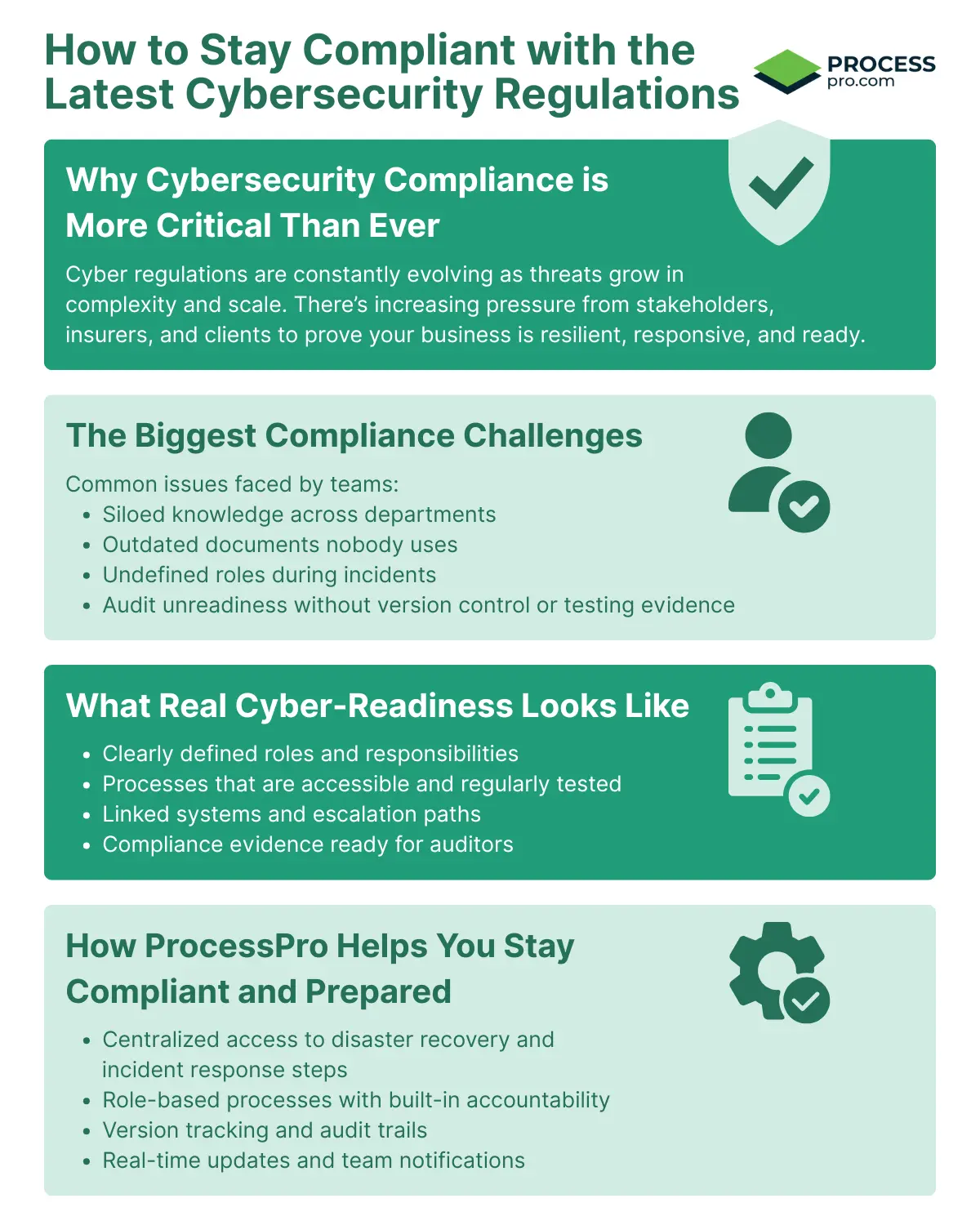Home » Improve cybersecurity compliance processes
Compliance and Risk Management
Improve cybersecurity compliance processes
Cyber threats aren’t just a possibility anymore, they’re a guarantee. From data breaches to ransomware attacks, businesses of every size and industry are under pressure to stay compliant with ever-evolving cybersecurity regulations. But ticking boxes isn’t enough. When a breach occurs, having a documented disaster recovery plan or cybersecurity compliance processes won’t help unless your team knows how to execute it, fast.
At SSOW Australia 2025, one message rang loud and clear: Cybersecurity isn’t just IT’s problem, it’s a process problem. And that means compliance needs to go beyond policies and checklists. Your team needs clarity, accountability, and tested procedures they can follow under pressure.
Staying compliant and operational in the face of cyber threats requires more than good intentions. It requires live, dynamic processes that everyone can access, understand, and act on, immediately.
Why cybersecurity compliance processes are more critical than ever
Cyber regulations are no longer static, they’re shifting constantly as threats grow in complexity and scale. From GDPR and POPIA, to ISO/IEC 27001 and evolving industry-specific mandates, cybersecurity compliance processes now demand proactive defense and proof of readiness.
Beyond the regulations, there’s growing pressure from stakeholders, insurers, and clients to demonstrate operational resilience. After all, a breach doesn’t just hurt your data, it damages trust, business continuity, and your reputation.
At SSOW 2025, Peter Tow of Western Sydney University highlighted the stark reality: Most businesses don’t fail because they’re attacked, they fail because their response is uncoordinated. A disaster recovery plan isn’t enough if it’s buried in a file no one can find. That’s why compliance today is about tested, role-based cybersecurity compliance processes that activate the moment things go wrong.
The biggest cybersecurity compliance processes challenges for shared services & IT teams
Most cybersecurity failures don’t come from lack of awareness, they come from a lack of clarity.
Here’s where teams are struggling:
- Siloed knowledge: IT might know the plan, but does HR? Procurement? Leadership?
- Outdated documents: Disaster recovery procedures often live in static Word files that no one updates, or reads.
- Undefined roles: When an attack hits, who leads? Who communicates? Who reports the incident? Delays in answering these questions cost time and credibility.
- Audit unreadiness: Many businesses can’t show version history or evidence of procedural testing when auditors request it.
The result? Even well-intentioned teams fall short of compliance simply because their cybersecurity compliance processes aren’t centralized, accessible, or operational.
What real cyber-readiness looks like
Real cyber-readiness isn’t just about having a policy document on file, it’s about making sure everyone knows what to do, when to do it, and how. In a crisis, confusion is costly. The faster your team can respond, the more likely you are to contain the damage and stay compliant.
Here’s what operational cyber-readiness looks like:
- Clearly defined roles and responsibilities
Everyone from IT to HR should know their role during a security incident. Who isolates systems? Who notifies leadership? Who contacts legal or external stakeholders? - Cybersecurity compliance processes that are visible and tested
Your disaster recovery and incident response processes shouldn’t live in someone’s inbox. They need to be accessible, version-controlled, and reviewed regularly through drills or simulations. - Linked systems and escalation paths
One process should lead logically into the next, containment, communication, reporting, and recovery. This makes cross-functional collaboration easier and faster. - Compliance evidence ready for auditors
When regulators or insurers come knocking, you should be able to show them exactly how your procedures are managed, updated, and followed, down to the version number and edit trail.
Ultimately, it’s not about having more documentation. It’s about having live, working processes that are ready to go on the moment your team needs them. This is where effective business process management makes a difference.

How ProcessPro helps you stay compliant and improve cybersecurity compliance processes
When a breach happens, you don’t have time to dig through files or guess who’s responsible for what. ProcessPro turns your cybersecurity plan into a live, executable system, so your team can respond with speed, clarity, and confidence.
Here’s how ProcessPro supports compliance and readiness:
- Centralized access to disaster recovery and incident response procedures
No more outdated Word docs or scattered files. Store every step in one place, structured by team and process, so everyone sees what’s relevant to them. - Role-based processes with accountability
Assign clear responsibilities for each task in your recovery or response plan. Everyone knows their role, deadlines, and who to escalate to if something stalls. - Version tracking and audit trails
Every change to your processes is tracked, providing instant proof of compliance for regulators, insurers, or internal audits. - Live updates and notifications
Need to adjust a procedure mid-crisis? Update it instantly and notify the team in real time, without reissuing static documents. - Test and improve continuously
Schedule drills, track response times, and refine your processes based on performance. ProcessPro helps to turn compliance into continuous improvement.
With ProcessPro, your cybersecurity compliance processes don’t just sit on paper, they run as a living part of your business
Don’t wait for a breach to test your processes
Cyber threats aren’t slowing down, and regulators aren’t waiting for you to catch up. The difference between a contained incident and a business-wide crisis often comes down to how quickly and clearly your team can act.
Turn your cybersecurity plan into a system that runs when it matters most.
Start building your live, testable response processes today with ProcessPro.
Because when every second counts, your team needs more than a policy, they need a process they can trust.
Book your demo today and be ready before the next threat hits.

James Ross
Founder & CEO. James is passionate about all thing Process Mapping and sharing his wealth of experience with his valued clients. He works closely with his teams to ensure that ProcessPro solves real everyday process mapping problems.
Share this article
